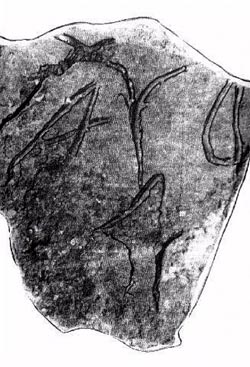

Neolithic facsimile to the classic Greek letters
A
ceramic fragment of 7,000-6,500 years ago is bearing the facsimile to
the classic Greek letters Alpha, Epsilon and Delta in a row. It cames
from the Cave of Cyclope at the desert islet Youra (Northern Sporades,
Greece).
This find proves that the classic Greek alphabet is older than the Greek
linear alphabets. It also disprove the theory that Greek alphabet derived
from the Phoenicians one, which is 3,500 years younger than the Cave of
Cyclope incised potsherds.
The discovery of this ceramic fragment of of Neolithic pot (5000-4500
BC) was conducted by the distinguished archaeologist Adamantios Sampson,
supervisor of the Inspectorate for Prehistoric and Classical Antiquities
of the Cyclades.
In a publication on the Cave of Cyclope deposit professor Sampson reported
that: "The Neolithic material was enriched with the unexpected recovery
of a small-sized sherd from a coarse close-shaped vase bearing incised
unidentifiable symbols. It is possible that it echoes evidence on an Aegean
Neolithic 'script' or 'proto-script', a very fashionable subject of discussion
in Greece, after similar finds in Kastoria lake, East Macedonia".
Who, in Greece, was writing in Greek more than 3,000 years before the
mythological "Greek speakers" supposedly migrated into this
land?
References:
Sampson
A., The Greek Neolithical Civilization, Goulandris Foundation, 1996.
Sampson A., Cave of Cyclope, Youra, Alonnessos, Ministry of Culture, 2000
